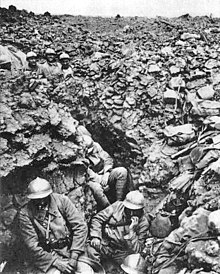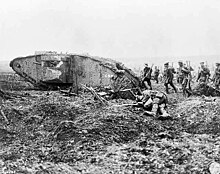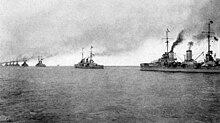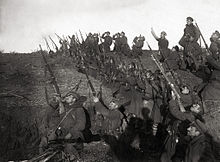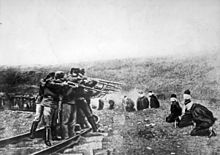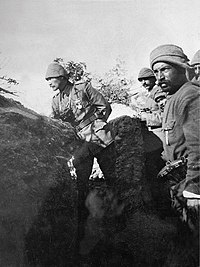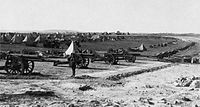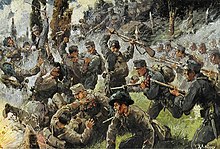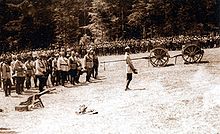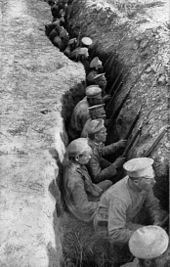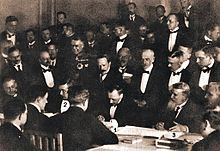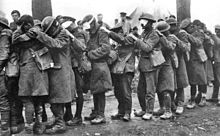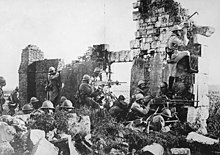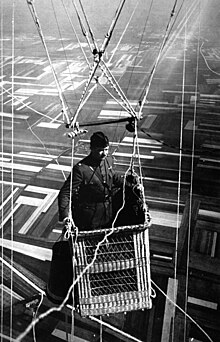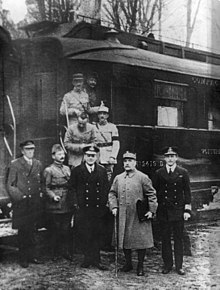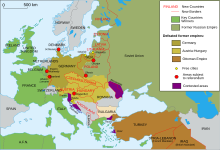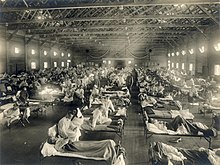Opening hostilities
Confusion among the Central Powers
The strategy of the Central Powers suffered from miscommunication. Germany had promised to support Austria-Hungarys invasion of Serbia, but interpretations of what this meant differed. Previously tested deployment plans had been replaced early in 1914, but those had never been tested in exercises. Austro-Hungarian leaders believed Germany would cover its northern flank against Russia.[44] Germany, however, envisioned Austria-Hungary directing most of its troops against Russia, while Germany dealt with France. This confusion forced the Austro-Hungarian Army to divide its forces between the Russian and Serbian fronts.
Serbian campaign
Austria invaded and fought the Serbian army at the Battle of Cer and Battle of Kolubara beginning on 12 August. Over the next two weeks, Austrian attacks were thrown back with heavy losses, which marked the first major Allied victories of the war and dashed Austro-Hungarian hopes of a swift victory. As a result, Austria had to keep sizable forces on the Serbian front, weakening its efforts against Russia.[45] Serbias defeat of the Austro-Hungarian invasion of 1914 counts among the major upset victories of the twentieth century.[46]
German forces in Belgium and France
At the outbreak of World War I, 80% of the German army was deployed as seven field armies in the west according to the plan Aufmarsch II West. However, they were then assigned to execute the retired deployment plan Aufmarsch I West, also known as the Schlieffen Plan. This would march German armies through northern Belgium and into France, in an attempt to encircle the French army and then breach the second defensive area of the fortresses of Verdun and Paris and the Marne river.[10]
Aufmarsch I West was one of four deployment plans available to the German General Staff in 1914. Each plan favoured certain operations, but did not specify exactly how those operations were to be carried out, leaving the commanding officers to carry those out at their own initiative and with minimal oversight.[clarification needed] Aufmarsch I West, designed for a one-front war with France, had been retired once it became clear it was irrelevant to the wars Germany could expect to face; both Russia and Britain were expected to help France, and there was no possibility of Italian nor Austro-Hungarian troops being available for operations against France. But despite its unsuitability, and the availability of more sensible and decisive options, it retained a certain allure due to its offensive nature and the pessimism of pre-war thinking, which expected offensive operations to be short-lived, costly in casualties, and unlikely to be decisive. Accordingly, the Aufmarsch II West deployment was changed for the offensive of 1914, despite its unrealistic goals and the insufficient forces Germany had available for decisive success.[47] Moltke took Schlieffens plan and modified the deployment of forces on the western front by reducing the right wing, the one to advance through Belgium, from 85% to 70%. In the end, the Schlieffen plan was so radically modified by Moltke, that it could be more properly called the Moltke Plan.[48]
The plan called for the right flank of the German advance to bypass the French armies concentrated on the Franco-German border, defeat the French forces closer to Luxembourg and Belgium and move south to Paris. Initially the Germans were successful, particularly in the Battle of the Frontiers (14–24 August). By 12 September, the French, with assistance from the British Expeditionary Force (BEF), halted the German advance east of Paris at the First Battle of the Marne (5–12 September) and pushed the German forces back some 50 km (31 mi). The French offensive into southern Alsace, launched on 20 August with the Battle of Mulhouse, had limited success.
In the east, Russia invaded with two armies. In response, Germany rapidly moved the 8th Field Army from its previous role as reserve for the invasion of France to East Prussia by rail across the German Empire. This army, led by general Paul von Hindenburg defeated Russia in a series of battles collectively known as the First Battle of Tannenberg (17 August – 2 September). While the Russian invasion failed, it caused the diversion of German troops to the east, allowing the tactical Allied victory at the First Battle of the Marne. This meant Germany failed to achieve its objective of avoiding a long, two-front war. However, the German army had fought its way into a good defensive position inside France and effectively halved Frances supply of coal. It had also killed or permanently crippled 230,000 more French and British troops than it itself had lost. Despite this, communications problems and questionable command decisions cost Germany the chance of a more decisive outcome.[49]
Asia and the Pacific
New Zealand occupied German Samoa (later Western Samoa) on 30 August 1914. On 11 September, the Australian Naval and Military Expeditionary Force landed on the island of Neu Pommern (later New Britain), which formed part of German New Guinea. On 28 October, the German cruiser SMS Emden sank the Russian cruiser Zhemchug in the Battle of Penang. Japan seized Germanys Micronesian colonies and, after the Siege of Tsingtao, the German coaling port of Qingdao on the Chinese Shandong peninsula. As Vienna refused to withdraw the Austro-Hungarian cruiser SMS Kaiserin Elisabeth from Tsingtao, Japan declared war not only on Germany, but also on Austria-Hungary; the ship participated in the defense of Tsingtao where it was sunk in November 1914.[50] Within a few months, the Allied forces had seized all the German territories in the Pacific; only isolated commerce raiders and a few holdouts in New Guinea remained.[51][52]
African campaigns
Some of the first clashes of the war involved British, French, and German colonial forces in Africa. On 6–7 August, French and British troops invaded the German protectorate of Togoland and Kamerun. On 10 August, German forces in South-West Africa attacked South Africa; sporadic and fierce fighting continued for the rest of the war. The German colonial forces in German East Africa, led by Colonel Paul von Lettow-Vorbeck, fought a guerrilla warfare campaign during World War I and only surrendered two weeks after the armistice took effect in Europe.[53]
Indian support for the Allies
Contrary to British fears of a revolt in India, the outbreak of the war saw an unprecedented outpouring of loyalty and goodwill towards Britain.[54][55] Indian political leaders from the Indian National Congress and other groups were eager to support the British war effort, since they believed that strong support for the war effort would further the cause of Indian Home Rule.[citation needed] The Indian Army in fact outnumbered the British Army at the beginning of the war; about 1.3 million Indian soldiers and labourers served in Europe, Africa, and the Middle East, while the central government and the princely states sent large supplies of food, money, and ammunition. In all, 140,000 men served on the Western Front and nearly 700,000 in the Middle East. Casualties of Indian soldiers totalled 47,746 killed and 65,126 wounded during World War I.[56] The suffering engendered by the war, as well as the failure of the British government to grant self-government to India after the end of hostilities, bred disillusionment and fuelled the campaign for full independence that would be led by Mohandas K. Gandhi and others.[citation needed]
Western Front
Trench warfare begins
Military tactics developed before World War I failed to keep pace with advances in technology and had become obsolete. These advances had allowed the creation of strong defensive systems, which out-of-date military tactics could not break through for most of the war. Barbed wire was a significant hindrance to massed infantry advances, while artillery, vastly more lethal than in the 1870s, coupled with machine guns, made crossing open ground extremely difficult.[57] Commanders on both sides failed to develop tactics for breaching entrenched positions without heavy casualties. In time, however, technology began to produce new offensive weapons, such as gas warfare and the tank.[58]
Just after the First Battle of the Marne (5–12 September 1914), Entente and German forces repeatedly attempted manoeuvring to the north in an effort to outflank each other: this series of manoeuvres became known as the "Race to the Sea". When these outflanking efforts failed, the opposing forces soon found themselves facing an uninterrupted line of entrenched positions from Lorraine to Belgiums coast.[10] Britain and France sought to take the offensive, while Germany defended the occupied territories. Consequently, German trenches were much better constructed than those of their enemy; Anglo-French trenches were only intended to be "temporary" before their forces broke through the German defences.[59]
Both sides tried to break the stalemate using scientific and technological advances. On 22 April 1915, at the Second Battle of Ypres, the Germans (violating the Hague Convention) used chlorine gas for the first time on the Western Front. Several types of gas soon became widely used by both sides, and though it never proved a decisive, battle-winning weapon, poison gas became one of the most-feared and best-remembered horrors of the war.[60][61] Tanks were developed by Britain and France, and were first used in combat by the British during the Battle of Flers–Courcelette (part of the Battle of the Somme) on 15 September 1916, with only partial success. However, their effectiveness would grow as the war progressed; the Allies built tanks in large numbers, whilst the Germans employed only a few of their own design, supplemented by captured Allied tanks.
Continuation of trench warfare
Neither side proved able to deliver a decisive blow for the next two years. Throughout 1915–17, the British Empire and France suffered more casualties than Germany, because of both the strategic and tactical stances chosen by the sides. Strategically, while the Germans only mounted one major offensive, the Allies made several attempts to break through the German lines.
In February 1916 the Germans attacked the French defensive positions at Verdun. Lasting until December 1916, the battle saw initial German gains, before French counter-attacks returned matters to near their starting point. Casualties were greater for the French, but the Germans bled heavily as well, with anywhere from 700,000[62] to 975,000[63] casualties suffered between the two combatants. Verdun became a symbol of French determination and self-sacrifice.[64]
The Battle of the Somme was an Anglo-French offensive of July to November 1916. The opening of this offensive (1 July 1916) saw the British Army endure the bloodiest day in its history, suffering 57,470 casualties, including 19,240 dead, on the first day alone. The entire Somme offensive cost the British Army some 420,000 casualties. The French suffered another estimated 200,000 casualties and the Germans an estimated 500,000.[65]
Protracted action at Verdun throughout 1916,[66] combined with the bloodletting at the Somme, brought the exhausted French army to the brink of collapse. Futile attempts using frontal assault came at a high price for both the British and the French and led to the widespread French Army Mutinies, after the failure of the costly Nivelle Offensive of April–May 1917.[67] The concurrent British Battle of Arras was more limited in scope, and more successful, although ultimately of little strategic value.[68][69] A smaller part of the Arras offensive, the capture of Vimy Ridge by the Canadian Corps, became highly significant to that country: the idea that Canadas national identity was born out of the battle is an opinion widely held in military and general histories of Canada.[70][71]
The last large-scale offensive of this period was a British attack (with French support) at Passchendaele (July–November 1917). This offensive opened with great promise for the Allies, before bogging down in the October mud. Casualties, though disputed, were roughly equal, at some 200,000–400,000 per side.
These years of trench warfare in the West saw no major exchanges of territory and, as a result, are often thought of as static and unchanging. However, throughout this period, British, French, and German tactics constantly evolved to meet new battlefield challenges.
At the start of the war, the German Empire had cruisers scattered across the globe, some of which were subsequently used to attack Allied merchant shipping. The British Royal Navy systematically hunted them down, though not without some embarrassment from its inability to protect Allied shipping. For example, the German detached light cruiser SMS Emden, part of the East-Asia squadron stationed at Qingdao, seized or destroyed 15 merchantmen, as well as sinking a Russian cruiser and a French destroyer. However, most of the German East-Asia squadron—consisting of the armoured cruisers Scharnhorst and Gneisenau , light cruisers Nürnberg and Leipzig and two transport ships—did not have orders to raid shipping and was instead underway to Germany when it met British warships. The German flotilla and Dresden sank two armoured cruisers at the Battle of Coronel, but was virtually destroyed at the Battle of the Falkland Islands in December 1914, with only Dresden and a few auxiliaries escaping, but after the Battle of Más a Tierra these too had been destroyed or interned.[72]
Soon after the outbreak of hostilities, Britain began a naval blockade of Germany. The strategy proved effective, cutting off vital military and civilian supplies, although this blockade violated accepted international law codified by several international agreements of the past two centuries.[73] Britain mined international waters to prevent any ships from entering entire sections of ocean, causing danger to even neutral ships.[74] Since there was limited response to this tactic of the British, Germany expected a similar response to its unrestricted submarine warfare.[75]
The Battle of Jutland (German: Skagerrakschlacht, or "Battle of the Skagerrak") developed into the largest naval battle of the war. It was the only full-scale clash of battleships during the war, and one of the largest in history. The Kaiserliche Marines High Seas Fleet, commanded by Vice Admiral Reinhard Scheer, fought the Royal Navys Grand Fleet, led by Admiral Sir John Jellicoe. The engagement was a stand off, as the Germans were outmanoeuvred by the larger British fleet, but managed to escape and inflicted more damage to the British fleet than they received. Strategically, however, the British asserted their control of the sea, and the bulk of the German surface fleet remained confined to port for the duration of the war.[76]
German U-boats attempted to cut the supply lines between North America and Britain.[77] The nature of submarine warfare meant that attacks often came without warning, giving the crews of the merchant ships little hope of survival.[77][78] The United States launched a protest, and Germany changed its rules of engagement. After the sinking of the passenger ship RMS Lusitania in 1915, Germany promised not to target passenger liners, while Britain armed its merchant ships, placing them beyond the protection of the "cruiser rules", which demanded warning and movement of crews to "a place of safety" (a standard that lifeboats did not meet).[79] Finally, in early 1917, Germany adopted a policy of unrestricted submarine warfare, realising that the Americans would eventually enter the war.[77][80] Germany sought to strangle Allied sea lanes before the United States could transport a large army overseas, but could maintain only five long-range U-boats on station, to limited effect.[77]
The U-boat threat lessened in 1917, when merchant ships began travelling in convoys, escorted by destroyers. This tactic made it difficult for U-boats to find targets, which significantly lessened losses; after the hydrophone and depth charges were introduced, accompanying destroyers could attack a submerged submarine with some hope of success. Convoys slowed the flow of supplies, since ships had to wait as convoys were assembled. The solution to the delays was an extensive program of building new freighters. Troopships were too fast for the submarines and did not travel the North Atlantic in convoys.[81] The U-boats had sunk more than 5,000 Allied ships, at a cost of 199 submarines.[82] World War I also saw the first use of aircraft carriers in combat, with HMS Furious launching Sopwith Camels in a successful raid against the Zeppelin hangars at Tondern in July 1918, as well as blimps for antisubmarine patrol.[83]
Southern theatres
War in the Balkans
Faced with Russia, Austria-Hungary could spare only one-third of its army to attack Serbia. After suffering heavy losses, the Austrians briefly occupied the Serbian capital, Belgrade. A Serbian counter-attack in the Battle of Kolubara succeeded in driving them from the country by the end of 1914. For the first ten months of 1915, Austria-Hungary used most of its military reserves to fight Italy. German and Austro-Hungarian diplomats, however, scored a coup by persuading Bulgaria to join the attack on Serbia.[85] The Austro-Hungarian provinces of Slovenia, Croatia and Bosnia provided troops for Austria-Hungary, in the fight with Serbia, Russia and Italy. Montenegro allied itself with Serbia.[86]
Bulgaria declared war on Serbia, October 12 and joined in the attack by the Austro-Hungarian army under Mackensens army of 250,000 that was already underway. Serbia was conquered in a little more than a month, as the Central Powers, now including Bulgaria, sent in 600,000 troops total. The Serbian army, fighting on two fronts and facing certain defeat, retreated into northern Albania. The Serbs suffered defeat in the Battle of Kosovo. Montenegro covered the Serbian retreat towards the Adriatic coast in the Battle of Mojkovac in 6–7 January 1916, but ultimately the Austrians also conquered Montenegro. The surviving Serbian soldiers were evacuated by ship to Greece.[87] After conquest, Serbia was divided between Austro-Hungary and Bulgaria.[88]
In late 1915, a Franco-British force landed at Salonica in Greece, to offer assistance and to pressure its government to declare war against the Central Powers. However, the pro-German King Constantine I dismissed the pro-Allied government of Eleftherios Venizelos before the Allied expeditionary force arrived.[89] The friction between the King of Greece and the Allies continued to accumulate with the National Schism, which effectively divided Greece between regions still loyal to the king and the new provisional government of Venizelos in Salonica. After intense negotiations and an armed confrontation in Athens between Allied and royalist forces (an incident known as Noemvriana), the King of Greece resigned and his second son Alexander took his place; Greece then officially joined the war on the side of the Allies.
In the beginning, the Macedonian Front was mostly static. French and Serbian forces retook limited areas of Macedonia by recapturing Bitola on 19 November 1916 following the costly Monastir Offensive, which brought stabilization of the front.[90]
Serbian and French troops finally made a breakthrough in September 1918, after most of the German and Austro-Hungarian troops had been withdrawn. The Bulgarians suffered their only defeat of the war at the Battle of Dobro Pole. Bulgaria capitulated two weeks later, on 29 September 1918.[91] The German high command responded by despatching troops to hold the line, but these forces were far too weak to reestablish a front.[92]
The disappearance of the Macedonian Front meant that the road to Budapest and Vienna was now opened to Allied forces. Hindenburg and Ludendorff concluded that the strategic and operational balance had now shifted decidedly against the Central Powers and, a day after the Bulgarian collapse, insisted on an immediate peace settlement.[93]
Ottoman Empire
The Ottoman Empire joined the Central Powers in the war with the secret Ottoman–German Alliance signed in August 1914.[94] The Ottomans threatened Russias Caucasian territories and Britains communications with India via the Suez Canal.
As the conflict progressed, the Ottoman Empire took advantage of the European powers preoccupation with the war and conducted large-scale ethnic cleansing of the indigenous Greek, Assyrian and Armenian Christian populations, known as the Greek genocide, Assyrian Genocide and Armenian genocide.[95][96][97]
The British and French opened overseas fronts with the Gallipoli (1915) and Mesopotamian campaigns (1914). In Gallipoli, the Ottoman Empire successfully repelled the British, French, and Australian and New Zealand Army Corps (ANZACs). In Mesopotamia, by contrast, after the defeat of the British defenders in the Siege of Kut by the Ottomans (1915–16), British Imperial forces reorganised and captured Baghdad in March 1917. The British were aided in Mesopotamia by local Arab and Assyrian tribesmen, while the Ottomans employed local Kurdish and Turcoman tribes.[98]
Further to the west, the Suez Canal was defended from Ottoman attacks in 1915 and 1916; in August, a German and Ottoman force was defeated at the Battle of Romani by the ANZAC Mounted Division and the 52nd (Lowland) Infantry Division. Following this victory, an Egyptian Expeditionary Force advanced across the Sinai Peninsula, pushing Ottoman forces back in the Battle of Magdhaba in December and the Battle of Rafa on the border between the Egyptian Sinai and Ottoman Palestine in January 1917.[99]
Russian armies generally saw success in the Caucasus. Enver Pasha, supreme commander of the Ottoman armed forces, was ambitious and dreamed of re-conquering central Asia and areas that had been lost to Russia previously. He was, however, a poor commander.[100] He launched an offensive against the Russians in the Caucasus in December 1914 with 100,000 troops; insisting on a frontal attack against mountainous Russian positions in winter. He lost 86% of his force at the Battle of Sarikamish.[101]
In December 1914 the Ottoman Empire, with German support, invaded Persia (modern Iran) in an effort to cut off British and Russian access to petroleum reservoirs around Baku near the Caspian Sea.[102] Persia, ostensibly neutral, had long been under the spheres of British and Russian influence. The Ottomans and Germans were aided by Kurdish and Azeri forces, together with a large number of major Iranian tribes, such as the Qashqai, Tangistanis, Luristanis, and Khamseh, while the Russians and British had the support of Assyrian and Armenian forces. The Persian Campaign was to last until 1918 and end in failure for the Ottomans and their allies. However the Russian withdrawal from the war in 1917 led to Armenian and Assyrian forces, who had hitherto inflicted a series of defeats upon the forces of the Ottomans and their allies, being cut off from supply lines, outnumbered, outgunned and isolated, forcing them to fight and flee towards British lines in northern Mesopotamia.[103]
General Yudenich, the Russian commander from 1915 to 1916, drove the Turks out of most of the southern Caucasus with a string of victories.[101] In 1917, Russian Grand Duke Nicholas assumed command of the Caucasus front. Nicholas planned a railway from Russian Georgia to the conquered territories, so that fresh supplies could be brought up for a new offensive in 1917. However, in March 1917 (February in the pre-revolutionary Russian calendar), the Czar abdicated in the course of the February Revolution and the Russian Caucasus Army began to fall apart.
The Arab Revolt, instigated by the Arab bureau of the British Foreign Office, started June 1916 with the Battle of Mecca, led by Sherif Hussein of Mecca, and ended with the Ottoman surrender of Damascus. Fakhri Pasha, the Ottoman commander of Medina, resisted for more than two and half years during the Siege of Medina before surrendering.[104]
The Senussi tribe, along the border of Italian Libya and British Egypt, incited and armed by the Turks, waged a small-scale guerrilla war against Allied troops. The British were forced to dispatch 12,000 troops to oppose them in the Senussi Campaign. Their rebellion was finally crushed in mid-1916.[105]
Total Allied casualties on the Ottoman fronts amounted 650,000 men. Total Ottoman casualties were 725,000 (325,000 dead and 400,000 wounded).[106]
Italian participation
Italy had been allied with the German and Austro-Hungarian Empires since 1882 as part of the Triple Alliance. However, the nation had its own designs on Austrian territory in Trentino, the Austrian Littoral, Fiume (Rijeka) and Dalmatia. Rome had a secret 1902 pact with France, effectively nullifying its part in the Triple Alliance.[107] At the start of hostilities, Italy refused to commit troops, arguing that the Triple Alliance was defensive and that Austria-Hungary was an aggressor. The Austro-Hungarian government began negotiations to secure Italian neutrality, offering the French colony of Tunisia in return. The Allies made a counter-offer in which Italy would receive the Southern Tyrol, Austrian Littoral and territory on the Dalmatian coast after the defeat of Austria-Hungary. This was formalised by the Treaty of London. Further encouraged by the Allied invasion of Turkey in April 1915, Italy joined the Triple Entente and declared war on Austria-Hungary on 23 May. Fifteen months later, Italy declared war on Germany.[108]
The Italians had numerical superiority but this advantage was lost, not only because of the difficult terrain in which the fighting took place, but also because of the strategies and tactics employed.[109] Field Marshal Luigi Cadorna, a staunch proponent of the frontal assault, had dreams of breaking into the Slovenian plateau, taking Ljubljana and threatening Vienna.
On the Trentino front, the Austro-Hungarians took advantage of the mountainous terrain, which favoured the defender. After an initial strategic retreat, the front remained largely unchanged, while Austrian Kaiserschützen and Standschützen engaged Italian Alpini in bitter hand-to-hand combat throughout the summer. The Austro-Hungarians counterattacked in the Altopiano of Asiago, towards Verona and Padua, in the spring of 1916 (Strafexpedition), but made little progress.[110]
Beginning in 1915, the Italians under Cadorna mounted eleven offensives on the Isonzo front along the Isonzo (Soča) River, northeast of Trieste. All eleven offensives were repelled by the Austro-Hungarians, who held the higher ground. In the summer of 1916, after the Battle of Doberdò, the Italians captured the town of Gorizia. After this minor victory, the front remained static for over a year, despite several Italian offensives, centred on the Banjšice and Karst Plateau east of Gorizia.
The Central Powers launched a crushing offensive on 26 October 1917, spearheaded by the Germans. They achieved a victory at Caporetto (Kobarid). The Italian Army was routed and retreated more than 100 kilometres (62 mi) to reorganise, stabilising the front at the Piave River. Since the Italian Army had suffered heavy losses in the Battle of Caporetto, the Italian Government called to arms the so-called 99 Boys (Ragazzi del 99): that is, all males born 1899 and prior, and so were 18 years old or older. In 1918, the Austro-Hungarians failed to break through in a series of battles on the Piave and were finally decisively defeated in the Battle of Vittorio Veneto in October of that year. On 1 November, the Italian Navy destroyed much of the Austro-Hungarian fleet stationed in Pula, preventing it from being handed over to the new State of Slovenes, Croats and Serbs. On 3 November, the Italians invaded Trieste from the sea. On the same day, the Armistice of Villa Giusti was signed. By mid-November 1918, the Italian military occupied the entire former Austrian Littoral and had seized control of the portion of Dalmatia that had been guaranteed to Italy by the London Pact.[111] By the end of hostilities in November 1918,[112] Admiral Enrico Millo declared himself Italys Governor of Dalmatia.[112] Austria-Hungary surrendered on 11 November 1918.[113][114]
Romanian participation
Romania had been allied with the Central Powers since 1882. When the war began, however, it declared its neutrality, arguing that because Austria-Hungary had itself declared war on Serbia, Romania was under no obligation to join the war. When the Entente Powers promised Romania Transylvania and Banat, large territories of eastern Hungary, in exchange for Romanias declaring war on the Central Powers, the Romanian government renounced its neutrality. On 27 August 1916, the Romanian Army launched an attack against Austria-Hungary, with limited Russian support. The Romanian offensive was initially successful, against the Austro-Hungarian troops in Transylvania, but a counterattack by the forces of the Central Powers drove them back.[115] As a result of the Battle of Bucharest, the Central Powers occupied Bucharest on 6 December 1916. Fighting in Moldova continued in 1917, resulting in a costly stalemate for the Central Powers.[116][117] Russian withdrawal from the war in late 1917 as a result of the October Revolution meant that Romania was forced to sign an armistice with the Central Powers on 9 December 1917.
In January 1918, Romanian forces established control over Bessarabia as the Russian Army abandoned the province. Although a treaty was signed by the Romanian and the Bolshevik Russian governments following talks from 5–9 March 1918 on the withdrawal of Romanian forces from Bessarabia within two months, on 27 March 1918 Romania attached Bessarabia to its territory, formally based on a resolution passed by the local assembly of that territory on its unification with Romania.[118]
Romania officially made peace with the Central Powers by signing the Treaty of Bucharest on 7 May 1918. Under that treaty, Romania was obliged to end the war with the Central Powers and make small territorial concessions to Austria-Hungary, ceding control of some passes in the Carpathian Mountains, and to grant oil concessions to Germany. In exchange, the Central Powers recognised the sovereignty of Romania over Bessarabia. The treaty was renounced in October 1918 by the Alexandru Marghiloman government, and Romania nominally re-entered the war on 10 November 1918. The next day, the Treaty of Bucharest was nullified by the terms of the Armistice of Compiègne.[119][120] Total Romanian deaths from 1914 to 1918, military and civilian, within contemporary borders, were estimated at 748,000.[121]
Eastern Front
Initial actions
While the Western Front had reached stalemate, the war continued in East Europe.[122] Initial Russian plans called for simultaneous invasions of Austrian Galicia and East Prussia. Although Russias initial advance into Galicia was largely successful, it was driven back from East Prussia by Hindenburg and Ludendorff at the Battle of Tannenberg and the Masurian Lakes in August and September 1914.[123][124] Russias less developed industrial base and ineffective military leadership were instrumental in the events that unfolded. By the spring of 1915, the Russians had retreated to Galicia, and, in May, the Central Powers achieved a remarkable breakthrough on Polands southern frontiers.[125] On 5 August, they captured Warsaw and forced the Russians to withdraw from Poland.
Russian Revolution
Despite Russias success with the June 1916 Brusilov Offensive in eastern Galicia,[126] dissatisfaction with the Russian governments conduct of the war grew. The offensives success was undermined by the reluctance of other generals to commit their forces to support the victory. Allied and Russian forces were revived only temporarily by Romanias entry into the war on 27 August. German forces came to the aid of embattled Austro-Hungarian units in Transylvania while a German-Bulgarian force attacked from the south, and Bucharest was retaken by the Central Powers on 6 December. Meanwhile, unrest grew in Russia, as the Tsar remained at the front. Empress Alexandras increasingly incompetent rule drew protests and resulted in the murder of her favourite, Rasputin, at the end of 1916.
In March 1917, demonstrations in Petrograd culminated in the abdication of Tsar Nicholas II and the appointment of a weak Provisional Government, which shared power with the Petrograd Soviet socialists. This arrangement led to confusion and chaos both at the front and at home. The army became increasingly ineffective.[125]
Following the Tsars abdication, Vladimir Lenin was ushered by train from Switzerland into Russia 16 April 1917, and financed by Germany. Discontent and the weaknesses of the Provisional Government led to a rise in the popularity of the Bolshevik Party, led by Lenin, which demanded an immediate end to the war. The Revolution of November was followed in December by an armistice and negotiations with Germany. At first, the Bolsheviks refused the German terms, but when German troops began marching across the Ukraine unopposed, the new government acceded to the Treaty of Brest-Litovsk on 3 March 1918. The treaty ceded vast territories, including Finland, the Baltic provinces, parts of Poland and Ukraine to the Central Powers.[127] Despite this enormous apparent German success, the manpower required for German occupation of former Russian territory may have contributed to the failure of the Spring Offensive and secured relatively little food or other materiel for the Central Powers war effort.
With the adoption of the Treaty of Brest-Litovsk, the Entente no longer existed. The Allied powers led a small-scale invasion of Russia, partly to stop Germany from exploiting Russian resources, and to a lesser extent, to support the "Whites" (as opposed to the "Reds") in the Russian Civil War.[128] Allied troops landed in Arkhangelsk and in Vladivostok as part of the North Russia Intervention.
Czechoslovak Legion
The Czechoslovak Legion fought with the Entente; their goal was to win support for the independence of Czechoslovakia. The Legion in Russia was established in September 1914, in December 1917 in France (including volunteers from America) and in April 1918 in Italy. Czechoslovak Legion troops defeated the Austro-Hungarian army at the Ukrainian village Zborov in July 1917. After this success, the number of Czechoslovak legionaries increased, as well as Czechoslovak military power. In the Battle of Bakhmach, the Legion defeated the Germans and forced them to make a truce.
In Russia, they were heavily involved in the Russian Civil War siding with the Whites against the Bolsheviks, at times controlling most of the Trans-Siberian railway and conquering all the major cities of Siberia. The presence of the Czechoslovak Legion near the Yekaterinburg appears to have been one of the motivations for the Bolshevik execution of the Tsar and his family in July 1918. Legionaries arrived less than a week afterwards and captured the city. Because Russias European ports were not safe, the corps was to be evacuated by a long detour via the port of Vladivostok. The last transport was the American ship Heffron in September 1920.
Central Powers peace overtures
In December 1916, after ten brutal months of the Battle of Verdun and a successful offensive against Romania, the Germans attempted to negotiate a peace with the Allies. Soon after, the US president, Woodrow Wilson, attempted to intervene as a peacemaker, asking in a note for both sides to state their demands. Lloyd Georges War Cabinet considered the German offer to be a ploy to create divisions amongst the Allies. After initial outrage and much deliberation, they took Wilsons note as a separate effort, signalling that the United States was on the verge of entering the war against Germany following the "submarine outrages". While the Allies debated a response to Wilsons offer, the Germans chose to rebuff it in favour of "a direct exchange of views". Learning of the German response, the Allied governments were free to make clear demands in their response of 14 January. They sought restoration of damages, the evacuation of occupied territories, reparations for France, Russia and Romania, and a recognition of the principle of nationalities. This included the liberation of Italians, Slavs, Romanians, Czecho-Slovaks, and the creation of a "free and united Poland". On the question of security, the Allies sought guarantees that would prevent or limit future wars, complete with sanctions, as a condition of any peace settlement.[129] The negotiations failed and the Entente powers rejected the German offer, because Germany did not state any specific proposals. The Entente powers stated to Wilson, that they would not start peace negotiations until the Central powers evacuated all occupied Allied territories and provided indemnities for all damage which had been done.[130]
1917–1918
Developments in 1917
Events of 1917 proved decisive in ending the war, although their effects were not fully felt until 1918.
The British naval blockade began to have a serious impact on Germany. In response, in February 1917, the German General Staff convinced Chancellor Theobald von Bethmann-Hollweg to declare unrestricted submarine warfare, with the goal of starving Britain out of the war. German planners estimated that unrestricted submarine warfare would cost Britain a monthly shipping loss of 600,000 tons. The General Staff acknowledged that the policy would almost certainly bring the United States into the conflict, but calculated that British shipping losses would be so high that they would be forced to sue for peace after 5 to 6 months, before American intervention could make an impact. In reality, tonnage sunk rose above 500,000 tons per month from February to July. It peaked at 860,000 tons in April. After July, the newly re-introduced convoy system became effective in reducing the U-boat threat. Britain was safe from starvation, while German industrial output fell and the United States joined the war far earlier than Germany had anticipated.
On 3 May 1917, during the Nivelle Offensive, the French 2nd Colonial Division, veterans of the Battle of Verdun, refused orders, arriving drunk and without their weapons. Their officers lacked the means to punish an entire division, and harsh measures were not immediately implemented. The French Army Mutinies eventually spread to a further 54 French divisions and saw 20,000 men desert. However, appeals to patriotism and duty, as well as mass arrests and trials, encouraged the soldiers to return to defend their trenches, although the French soldiers refused to participate in further offensive action.[131] Robert Nivelle was removed from command by 15 May, replaced by General Philippe Pétain, who suspended bloody large-scale attacks.
The victory of he central powers at the Battle of Caporetto led the Allies to convene the Rapallo Conference at which they formed the Supreme War Council to coordinate planning. Previously, British and French armies had operated under separate commands.
In December, the Central Powers signed an armistice with Russia, thus freeing large numbers of German troops for use in the west. With German reinforcements and new American troops pouring in, the outcome was to be decided on the Western Front. The Central Powers knew that they could not win a protracted war, but they held high hopes for success based on a final quick offensive. Furthermore, the both sides became increasingly fearful of social unrest and revolution in Europe. Thus, both sides urgently sought a decisive victory.[132]
In 1917, Emperor Charles I of Austria secretly attempted separate peace negotiations with Clemenceau, through his wifes brother Sixtus in Belgium as an intermediary, without the knowledge of Germany. Italy opposed the proposals. When the negotiations failed, his attempt was revealed to Germany resulting in a diplomatic catastrophe.[133][134]
Ottoman Empire conflict, 1917–1918
In March and April 1917, at the First and Second Battles of Gaza, German and Ottoman forces stopped the advance of the Egyptian Expeditionary Force, which had begun in August 1916 at the Battle of Romani.[135][136] At the end of October, the Sinai and Palestine Campaign resumed, when General Edmund Allenbys XXth Corps, XXI Corps and Desert Mounted Corps won the Battle of Beersheba.[137] Two Ottoman armies were defeated a few weeks later at the Battle of Mughar Ridge and, early in December, Jerusalem was captured following another Ottoman defeat at the Battle of Jerusalem (1917).[138][139][140] About this time, Friedrich Freiherr Kress von Kressenstein was relieved of his duties as the Eighth Armys commander, replaced by Djevad Pasha, and a few months later the commander of the Ottoman Army in Palestine, Erich von Falkenhayn, was replaced by Otto Liman von Sanders.[141][142]
In early in 1918, the front line was extended and the Jordan Valley was occupied, following the First Transjordan and the Second Transjordan attack by British Empire forces in March and April 1918.[143] In March, most of the Egyptian Expeditionary Forces British infantry and Yeomanry cavalry were sent to the Western Front as a consequence of the Spring Offensive. They were replaced by Indian Army units. During several months of reorganisation and training of the summer, a number of attacks were carried out on sections of the Ottoman front line. These pushed the front line north to more advantageous positions for the Entente in preparation for an attack and to acclimatise the newly arrived Indian Army infantry. It was not until the middle of September that the integrated force was ready for large-scale operations.
The reorganised Egyptian Expeditionary Force, with an additional mounted division, broke Ottoman forces at the Battle of Megiddo in September 1918. In two days the British and Indian infantry, supported by a creeping barrage, broke the Ottoman front line and captured the headquarters of the Eighth Army (Ottoman Empire) at Tulkarm, the continuous trench lines at Tabsor, Arara and the Seventh Army (Ottoman Empire) headquarters at Nablus. The Desert Mounted Corps rode through the break in the front line created by the infantry and, during virtually continuous operations by Australian Light Horse, British mounted Yeomanry, Indian Lancers and New Zealand Mounted Rifle brigades in the Jezreel Valley, they captured Nazareth, Afulah and Beisan, Jenin, along with Haifa on the Mediterranean coast and Daraa east of the Jordan River on the Hejaz railway. Samakh and Tiberias on the Sea of Galilee, were captured on the way northwards to Damascus. Meanwhile, Chaytors Force of Australian light horse, New Zealand mounted rifles, Indian, British West Indies and Jewish infantry captured the crossings of the Jordan River, Es Salt, Amman and at Ziza most of the Fourth Army (Ottoman Empire). The Armistice of Mudros, signed at the end of October, ended hostilities with the Ottoman Empire when fighting was continuing north of Aleppo.
Entry of the United States
At the outbreak of the war, the United States pursued a policy of non-intervention, avoiding conflict while trying to broker a peace. When the German U-boat SM U-20 sank the British liner RMS Lusitania on 7 May 1915 with 128 Americans among the dead, President Woodrow Wilson insisted that "America is too proud to fight" but demanded an end to attacks on passenger ships. Germany complied. Wilson unsuccessfully tried to mediate a settlement. However, he also repeatedly warned that the United States would not tolerate unrestricted submarine warfare, in violation of international law. The former president Theodore Roosevelt denounced German acts as "piracy".[144] Wilson was narrowly reelected in 1916 as his supporters emphasized "he kept us out of war".
In January 1917, Germany resumed unrestricted submarine warfare, realizing it would mean American entry. The German Foreign Minister, in the Zimmermann Telegram, invited Mexico to join the war as Germanys ally against the United States. In return, the Germans would finance Mexicos war and help it recover the territories of Texas, New Mexico, and Arizona.[145] The United Kingdom intercepted the message and presented it to the US embassy in the UK. From there it made its way to President Wilson who released the Zimmermann note to the public, and Americans saw it as casus belli. Wilson called on antiwar elements to end all wars, by winning this one and eliminating militarism from the globe. He argued that the war was so important that the US had to have a voice in the peace conference.[146] After the sinking of seven US merchant ships by submarines and the publication of the Zimmermann telegram, Wilson called for war on Germany,[147] which the US Congress declared on 6 April 1917.
The United States was never formally a member of the Allies but became a self-styled "Associated Power". The United States had a small army, but, after the passage of the Selective Service Act, it drafted 2.8 million men,[148] and, by summer 1918, was sending 10,000 fresh soldiers to France every day. In 1917, the US Congress gave US citizenship to Puerto Ricans when they were drafted to participate in World War I, as part of the Jones Act. If Germany believed it would be many more months before American soldiers would arrive and that their arrival could be stopped by U-boats, it had miscalculated.[149]
The United States Navy sent a battleship group to Scapa Flow to join with the British Grand Fleet, destroyers to Queenstown, Ireland, and submarines to help guard convoys. Several regiments of US Marines were also dispatched to France. The British and French wanted American units used to reinforce their troops already on the battle lines and not waste scarce shipping on bringing over supplies. General John J. Pershing, American Expeditionary Forces (AEF) commander, refused to break up American units to be used as filler material. As an exception, he did allow African-American combat regiments to be used in French divisions. The Harlem Hellfighters fought as part of the French 16th Division, and earned a unit Croix de Guerre for their actions at Château-Thierry, Belleau Wood, and Sechault.[150] AEF doctrine called for the use of frontal assaults, which had long since been discarded by British Empire and French commanders due to the large loss of life that resulted.[151]
German Spring Offensive of 1918
Ludendorff drew up plans (codenamed Operation Michael) for the 1918 offensive on the Western Front. The Spring Offensive sought to divide the British and French forces with a series of feints and advances. The German leadership hoped to end the war before significant US forces arrived. The operation commenced on 21 March 1918, with an attack on British forces near Saint-Quentin. German forces achieved an unprecedented advance of 60 kilometres (37 mi).[152]
British and French trenches were penetrated using novel infiltration tactics, also named Hutier tactics, after General Oskar von Hutier, by specially trained units called stormtroopers. Previously, attacks had been characterised by long artillery bombardments and massed assaults. However, in the Spring Offensive of 1918, Ludendorff used artillery only briefly and infiltrated small groups of infantry at weak points. They attacked command and logistics areas and bypassed points of serious resistance. More heavily armed infantry then destroyed these isolated positions. This German success relied greatly on the element of surprise.[153]
The front moved to within 120 kilometres (75 mi) of Paris. Three heavy Krupp railway guns fired 183 shells on the capital, causing many Parisians to flee. The initial offensive was so successful that Kaiser Wilhelm II declared 24 March a national holiday. Many Germans thought victory was near. After heavy fighting, however, the offensive was halted. Lacking tanks or motorised artillery, the Germans were unable to consolidate their gains. The problems of re-supply were also exacerbated by increasing distances that now stretched over terrain that was shell-torn and often impassable to traffic.[154]
General Foch pressed to use the arriving American troops as individual replacements, whereas Pershing sought to field American units as an independent force. These units were assigned to the depleted French and British Empire commands on 28 March. A Supreme War Council of Allied forces was created at the Doullens Conference on 5 November 1917. General Foch was appointed as supreme commander of the Allied forces. Haig, Petain, and Pershing retained tactical control of their respective armies; Foch assumed a coordinating rather than a directing role, and the British, French, and US commands operated largely independently.[155]
Following Operation Michael, Germany launched Operation Georgette against the northern English Channel ports. The Allies halted the drive after limited territorial gains by Germany. The German Army to the south then conducted Operations Blücher and Yorck, pushing broadly towards Paris. Germany launched Operation Marne (Second Battle of the Marne) 15 July, in an attempt to encircle Reims. The resulting counterattack, which started the Hundred Days Offensive, marked the first successful Allied offensive of the war.
By 20 July, the Germans had retreated across the Marne to their starting lines,[156] having achieved little, and the German Army never regained the initiative. German casualties between March and April 1918 were 270,000, including many highly trained storm troopers.
Meanwhile, Germany was falling apart at home. Anti-war marches became frequent and morale in the army fell. Industrial output was half the 1913 levels.
New states under war zone
In the late spring of 1918, three new states were formed in the South Caucasus: the First Republic of Armenia, the Azerbaijan Democratic Republic, and the Democratic Republic of Georgia, which declared their independence from the Russian Empire. Two other minor entities were established, the Centrocaspian Dictatorship and South West Caucasian Republic (the former was liquidated by Azerbaijan in the autumn of 1918 and the latter by a joint Armenian-British task force in early 1919). With the withdrawal of the Russian armies from the Caucasus front in the winter of 1917–18, the three major republics braced for an imminent Ottoman advance, which commenced in the early months of 1918. Solidarity was briefly maintained when the Transcaucasian Federative Republic was created in the spring of 1918, but this collapsed in May, when the Georgians asked and received protection from Germany and the Azerbaijanis concluded a treaty with the Ottoman Empire that was more akin to a military alliance. Armenia was left to fend for itself and struggled for five months against the threat of a full-fledged occupation by the Ottoman Turks.[157]
Allied victory: summer 1918 onwards
Hundred Days Offensive
The Allied counteroffensive, known as the Hundred Days Offensive, began on 8 August 1918, with the Battle of Amiens. The battle involved over 400 tanks and 120,000 British, Dominion, and French troops, and by the end of its first day a gap 15 mi (24 km) long had been created in the German lines. The defenders displayed a marked collapse in morale, causing Ludendorff to refer to this day as the "Black Day of the German army".[159][160][better source needed] After an advance as far as 14 miles (23 km), German resistance stiffened, and the battle was concluded on 12 August.
Rather than continuing the Amiens battle past the point of initial success, as had been done so many times in the past, the Allies shifted their attention elsewhere. Allied leaders had now realised that to continue an attack after resistance had hardened was a waste of lives, and it was better to turn a line than to try to roll over it. They began to undertake attacks in quick order to take advantage of successful advances on the flanks, then broke them off when each attack lost its initial impetus.[161]
British and Dominion forces launched the next phase of the campaign with the Battle of Albert on 21 August.[162] The assault was widened by French[163] and then further British forces in the following days. During the last week of August the pressure along a 70-mile (113 km) front against the enemy was heavy and unrelenting. From German accounts, "Each day was spent in bloody fighting against an ever and again on-storming enemy, and nights passed without sleep in retirements to new lines."[161]
Faced with these advances, on 2 September the German Supreme Army Command issued orders to withdraw to the Hindenburg Line in the south. This ceded without a fight the salient seized the previous April.[164] According to Ludendorff "We had to admit the necessity ... to withdraw the entire front from the Scarpe to the Vesle.[165]
September saw the Allies advance to the Hindenburg Line in the north and centre. The Germans continued to fight strong rear-guard actions and launched numerous counterattacks on lost positions, but only a few succeeded, and those only temporarily. Contested towns, villages, heights, and trenches in the screening positions and outposts of the Hindenburg Line continued to fall to the Allies, with the BEF alone taking 30,441 prisoners in the last week of September. On 24 September an assault by both the British and French came within 2 miles (3.2 km) of St. Quentin.[163] The Germans had now retreated to positions along or behind the Hindenburg Line.
In nearly four weeks of fighting beginning 8 August, over 100,000 German prisoners were taken. As of "The Black Day of the German Army", the German High Command realised that the war was lost and made attempts to reach a satisfactory end. The day after that battle, Ludendorff said: "We cannot win the war any more, but we must not lose it either." On 11 August he offered his resignation to the Kaiser, who refused it, replying, "I see that we must strike a balance. We have nearly reached the limit of our powers of resistance. The war must be ended." On 13 August, at Spa, Hindenburg, Ludendorff, the Chancellor, and Foreign Minister Hintz agreed that the war could not be ended militarily and, on the following day, the German Crown Council decided that victory in the field was now most improbable. Austria and Hungary warned that they could only continue the war until December, and Ludendorff recommended immediate peace negotiations. Prince Rupprecht warned Prince Max of Baden: "Our military situation has deteriorated so rapidly that I no longer believe we can hold out over the winter; it is even possible that a catastrophe will come earlier." On 10 September Hindenburg urged peace moves to Emperor Charles of Austria, and Germany appealed to the Netherlands for mediation. On 14 September Austria sent a note to all belligerents and neutrals suggesting a meeting for peace talks on neutral soil, and on 15 September Germany made a peace offer to Belgium. Both peace offers were rejected, and on 24 September Supreme Army Command informed the leaders in Berlin that armistice talks were inevitable.[163]
The final assault on the Hindenburg Line began with the Meuse-Argonne Offensive, launched by French and American troops on 26 September. The following week, cooperating French and American units broke through in Champagne at the Battle of Blanc Mont Ridge, forcing the Germans off the commanding heights, and closing towards the Belgian frontier.[166] On 8 October the line was pierced again by British and Dominion troops at the Battle of Cambrai.[167] The German army had to shorten its front and use the Dutch frontier as an anchor to fight rear-guard actions as it fell back towards Germany.
When Bulgaria signed a separate armistice on 29 September, Ludendorff, having been under great stress for months, suffered something similar to a breakdown. It was evident that Germany could no longer mount a successful defence.[168][169]
News of Germanys impending military defeat spread throughout the German armed forces. The threat of mutiny was rife. Admiral Reinhard Scheer and Ludendorff decided to launch a last attempt to restore the "valour" of the German Navy. Knowing the government of Prince Maximilian of Baden would veto any such action, Ludendorff decided not to inform him. Nonetheless, word of the impending assault reached sailors at Kiel. Many, refusing to be part of a naval offensive, which they believed to be suicidal, rebelled and were arrested. Ludendorff took the blame; the Kaiser dismissed him on 26 October. The collapse of the Balkans meant that Germany was about to lose its main supplies of oil and food. Its reserves had been used up, even as US troops kept arriving at the rate of 10,000 per day.[170] The Americans supplied more than 80% of Allied oil during the war, and there was no shortage.[171]
With the military faltering and with widespread loss of confidence in the Kaiser, Germany moved towards surrender. Prince Maximilian of Baden took charge of a new government as Chancellor of Germany to negotiate with the Allies. Negotiations with President Wilson began immediately, in the hope that he would offer better terms than the British and French. Wilson demanded a constitutional monarchy and parliamentary control over the German military.[172] There was no resistance when the Social Democrat Philipp Scheidemann on 9 November declared Germany to be a republic. The Kaiser, kings and other hereditary rulers all were removed from power and Wilhelm fled to exile in the Netherlands. Imperial Germany was dead; a new Germany had been born as the Weimar Republic.[173]
Armistices and capitulations
The collapse of the Central Powers came swiftly. Bulgaria was the first to sign an armistice, on 29 September 1918 at Saloniki.[175] On 30 October, the Ottoman Empire capitulated, signing the Armistice of Mudros.[175]
On 24 October, the Italians began a push that rapidly recovered territory lost after the Battle of Caporetto. This culminated in the Battle of Vittorio Veneto, which marked the end of the Austro-Hungarian Army as an effective fighting force. The offensive also triggered the disintegration of the Austro-Hungarian Empire. During the last week of October, declarations of independence were made in Budapest, Prague, and Zagreb. On 29 October, the imperial authorities asked Italy for an armistice. But the Italians continued advancing, reaching Trento, Udine, and Trieste. On 3 November, Austria-Hungary sent a flag of truce to ask for an armistice (Armistice of Villa Giusti). The terms, arranged by telegraph with the Allied Authorities in Paris, were communicated to the Austrian commander and accepted. The Armistice with Austria was signed in the Villa Giusti, near Padua, on 3 November. Austria and Hungary signed separate armistices following the overthrow of the Habsburg Monarchy.
On 11 November, at 5:00 am, an armistice with Germany was signed in a railroad carriage at Compiègne. At 11 am on 11 November 1918—"the eleventh hour of the eleventh day of the eleventh month"—a ceasefire came into effect. During the six hours between the signing of the armistice and its taking effect, opposing armies on the Western Front began to withdraw from their positions, but fighting continued along many areas of the front, as commanders wanted to capture territory before the war ended.
The occupation of the Rhineland took place following the Armistice. The occupying armies consisted of American, Belgian, British and French forces.
In November 1918, the Allies had ample supplies of men and materiel to invade Germany. Yet at the time of the armistice, no Allied force had crossed the German frontier; the Western Front was still some 450 mi (720 km) from Berlin; and the Kaisers armies had retreated from the battlefield in good order. These factors enabled Hindenburg and other senior German leaders to spread the story that their armies had not really been defeated. This resulted in the stab-in-the-back legend,[176][177] which attributed Germanys defeat not to its inability to continue fighting (even though up to a million soldiers were suffering from the 1918 flu pandemic and unfit to fight), but to the publics failure to respond to its "patriotic calling" and the supposed intentional sabotage of the war effort, particularly by Jews, Socialists, and Bolsheviks.
The Allies had much more potential wealth they could spend on the war. One estimate (using 1913 US dollars) is that the Allies spent $58 billion on the war and the Central Powers only $25 billion. Among the Allies, the UK spent $21 billion and the US $17 billion; among the Central Powers Germany spent $20 billion.[178]
Aftermath
In the aftermath of the war, four empires disappeared: the German, Austro-Hungarian, Ottoman, and Russian. Numerous nations regained their former independence, and new ones created. Four dynasties, together with their ancillary aristocracies, all fell as a result of the war: the Romanovs, the Hohenzollerns, the Habsburgs, and the Ottomans. Belgium and Serbia were badly damaged, as was France, with 1.4 million soldiers dead,[179] not counting other casualties. Germany and Russia were similarly affected.[180]
Formal end of the war
A formal state of war between the two sides persisted for another seven months, until the signing of the Treaty of Versailles with Germany on 28 June 1919. The United States Senate did not ratify the treaty despite public support for it,[181][182] and did not formally end its involvement in the war until the Knox–Porter Resolution was signed on 2 July 1921 by President Warren G. Harding.[183] For the United Kingdom and the British Empire, the state of war ceased under the provisions of the Termination of the Present War (Definition) Act 1918 with respect to:
After the Treaty of Versailles, treaties with Austria, Hungary, Bulgaria, and the Ottoman Empire were signed. However, the negotiation of the latter treaty with the Ottoman Empire was followed by strife (the Turkish War of Independence), and a final peace treaty between the Allied Powers and the country that would shortly become the Republic of Turkey was not signed until 24 July 1923, at Lausanne.
Some war memorials date the end of the war as being when the Versailles Treaty was signed in 1919, which was when many of the troops serving abroad finally returned to their home countries; by contrast, most commemorations of the wars end concentrate on the armistice of 11 November 1918. Legally, the formal peace treaties were not complete until the last, the Treaty of Lausanne, was signed. Under its terms, the Allied forces divested Constantinople on 23 August 1923.
Peace treaties and national boundaries
After the war, the Paris Peace Conference imposed a series of peace treaties on the Central Powers officially ending the war. The 1919 Treaty of Versailles dealt with Germany, and building on Wilsons 14th point, brought into being the League of Nations on 28 June 1919.[189][190]
The Central Powers had to acknowledge responsibility for "all the loss and damage to which the Allied and Associated Governments and their nationals have been subjected as a consequence of the war imposed upon them by" their aggression. In the Treaty of Versailles, this statement was Article 231. This article became known as War Guilt clause as the majority of Germans felt humiliated and resentful.[191] Overall the Germans felt they had been unjustly dealt by what they called the "diktat of Versailles." Schulze says, the Treaty placed Germany, "under legal sanctions, deprived of military power, economically ruined, and politically humiliated."[192] Belgian historian Laurence Van Ypersele emphasizes the central role played by memory of the war and the Versailles Treaty in German politics in the 1920s and 1930s:
Active denial of war guilt in Germany and German resentment at both reparations and continued Allied occupation of the Rhineland made widespread revision of the meaning and memory of the war problematic. The legend of the "stab in the back" and the wish to revise the "Versailles diktat", and the belief in an international threat aimed at the elimination of the German nation persisted at the heart of German politics. Even a man of peace such as Stresemann publicly rejected German guilt. As for the Nazis, they waved the banners of domestic treason and international conspiracy in an attempt to galvanize the German nation into a spirit of revenge. Like a Fascist Italy, Nazi Germany sought to redirect the memory of the war to the benefit of its own policies.[193]
Meanwhile, new nations liberated from German rule viewed the treaty as recognition of wrongs committed against small nations by much larger aggressive neighbors.[194] The Peace Conference required all the defeated powers to pay reparations for all the damage done to civilians. However, owing to economic difficulties and Germany being the only defeated power with an intact economy, the burden fell largely on Germany.
Austria-Hungary was partitioned into several successor states, including Austria, Hungary, Czechoslovakia and Yugoslavia, largely but not entirely along ethnic lines. Transylvania was shifted from Hungary to Greater Romania. The details were contained in the Treaty of Saint-Germain and the Treaty of Trianon. As a result of the Treaty of Trianon, 3.3 million Hungarians came under foreign rule. Although the Hungarians made up 54% of the population of the pre-war Kingdom of Hungary, only 32% of its territory was left to Hungary. Between 1920 and 1924, 354,000 Hungarians fled former Hungarian territories attached to Romania, Czechoslovakia, and Yugoslavia.[195]
The Russian Empire, which had withdrawn from the war in 1917 after the October Revolution, lost much of its western frontier as the newly independent nations of Estonia, Finland, Latvia, Lithuania, and Poland were carved from it. Romania took control of Bessarabia in April 1918.[196]
The Ottoman Empire disintegrated, and much of its non-Anatolian territory was awarded to various Allied powers as protectorates. The Turkish core in Anatolia was reorganised as the Republic of Turkey. The Ottoman Empire was to be partitioned by the Treaty of Sèvres of 1920. This treaty was never ratified by the Sultan and was rejected by the Turkish National Movement, leading to the victorious Turkish War of Independence and the much less stringent 1923 Treaty of Lausanne.
National identities
Poland reemerged as an independent country, after more than a century. The Kingdom of Serbia and its dynasty, as a "minor Entente nation" and the country with the most casualties per capita,[197][198][199] became the backbone of a new multinational state, the Kingdom of Serbs, Croats and Slovenes, later renamed Yugoslavia. Czechoslovakia, combining the Kingdom of Bohemia with parts of the Kingdom of Hungary, became a new nation. Russia became the Soviet Union and lost Finland, Estonia, Lithuania, and Latvia, which became independent countries. The Ottoman Empire was soon replaced by Turkey and several other countries in the Middle East.
In the British Empire, the war unleashed new forms of nationalism. In Australia and New Zealand the Battle of Gallipoli became known as those nations "Baptism of Fire". It was the first major war in which the newly established countries fought, and it was one of the first times that Australian troops fought as Australians, not just subjects of the British Crown. Anzac Day, commemorating the Australian and New Zealand Army Corps, celebrates this defining moment.[200][201]
After the Battle of Vimy Ridge, where the Canadian divisions fought together for the first time as a single corps, Canadians began to refer to theirs as a nation "forged from fire".[202] Having succeeded on the same battleground where the "mother countries" had previously faltered, they were for the first time respected internationally for their own accomplishments. Canada entered the war as a Dominion of the British Empire and remained so, although it emerged with a greater measure of independence.[203][204] When Britain declared war in 1914, the dominions were automatically at war; at the conclusion, Canada, Australia, New Zealand, and South Africa were individual signatories of the Treaty of Versailles.[205]
The establishment of the modern state of Israel and the roots of the continuing Israeli–Palestinian conflict are partially found in the unstable power dynamics of the Middle East that resulted from World War I.[206] Before the end of the war, the Ottoman Empire had maintained a modest level of peace and stability throughout the Middle East.[207] With the fall of the Ottoman government, power vacuums developed and conflicting claims to land and nationhood began to emerge.[208] The political boundaries drawn by the victors of World War I were quickly imposed, sometimes after only cursory consultation with the local population. These continue to be problematic in the 21st-century struggles for national identity.[209][210] While the dissolution of the Ottoman Empire at the end of World War I was pivotal in contributing to the modern political situation of the Middle East, including the Arab-Israeli conflict,[211][212][213] the end of Ottoman rule also spawned lesser known disputes over water and other natural resources.[214]
Health effects
The war had profound consequences in the health of soldiers. Of the 60 million European military personnel who were mobilized from 1914 to 1918, 8 million were killed, 7 million were permanently disabled, and 15 million were seriously injured. Germany lost 15.1% of its active male population, Austria-Hungary lost 17.1%, and France lost 10.5%.[215] In Germany, civilian deaths were 474,000 higher than in peacetime, due in large part to food shortages and malnutrition that weakened resistance to disease.[216] By the end of the war, starvation caused by famine had killed approximately 100,000 people in Lebanon.[217] Between 5 and 10 million people died in the Russian famine of 1921.[218] By 1922, there were between 4.5 million and 7 million homeless children in Russia as a result of nearly a decade of devastation from World War I, the Russian Civil War, and the subsequent famine of 1920–1922.[219] Numerous anti-Soviet Russians fled the country after the Revolution; by the 1930s, the northern Chinese city of Harbin had 100,000 Russians.[220] Thousands more emigrated to France, England, and the United States.
In Australia, the effects of the war on the economy were no less severe. The Australian prime minister, Billy Hughes, wrote to the British prime minister, Lloyd George, "You have assured us that you cannot get better terms. I much regret it, and hope even now that some way may be found of securing agreement for demanding reparation commensurate with the tremendous sacrifices made by the British Empire and her Allies." Australia received ₤5,571,720 war reparations, but the direct cost of the war to Australia had been ₤376,993,052, and, by the mid-1930s, repatriation pensions, war gratuities, interest and sinking fund charges were ₤831,280,947.[221] Of about 416,000 Australians who served, about 60,000 were killed and another 152,000 were wounded.[222]
Diseases flourished in the chaotic wartime conditions. In 1914 alone, louse-borne epidemic typhus killed 200,000 in Serbia.[223] From 1918 to 1922, Russia had about 25 million infections and 3 million deaths from epidemic typhus.[224] In 1923, 13 million Russians contracted malaria, a sharp increase from the pre-war years.[225] In addition, a major influenza epidemic spread around the world. Overall, the 1918 flu pandemic killed at least 50 million people.[226][227]
Lobbying by Chaim Weizmann and fear that American Jews would encourage the United States to support Germany culminated in the British governments Balfour Declaration of 1917, endorsing creation of a Jewish homeland in Palestine.[228] A total of more than 1,172,000 Jewish soldiers served in the Allied and Central Power forces in World War I, including 275,000 in Austria-Hungary and 450,000 in Czarist Russia.[229]
The social disruption and widespread violence of the Russian Revolution of 1917 and the ensuing Russian Civil War sparked more than 2,000 pogroms in the former Russian Empire, mostly in Ukraine.[230] An estimated 60,000–200,000 civilian Jews were killed in the atrocities.[231]
In the aftermath of World War I, Greece fought against Turkish nationalists led by Mustafa Kemal, a war which eventually resulted in a massive population exchange between the two countries under the Treaty of Lausanne.[232] According to various sources,[233] several hundred thousand Greeks died during this period, which was tied in with the Greek Genocide.[234]





